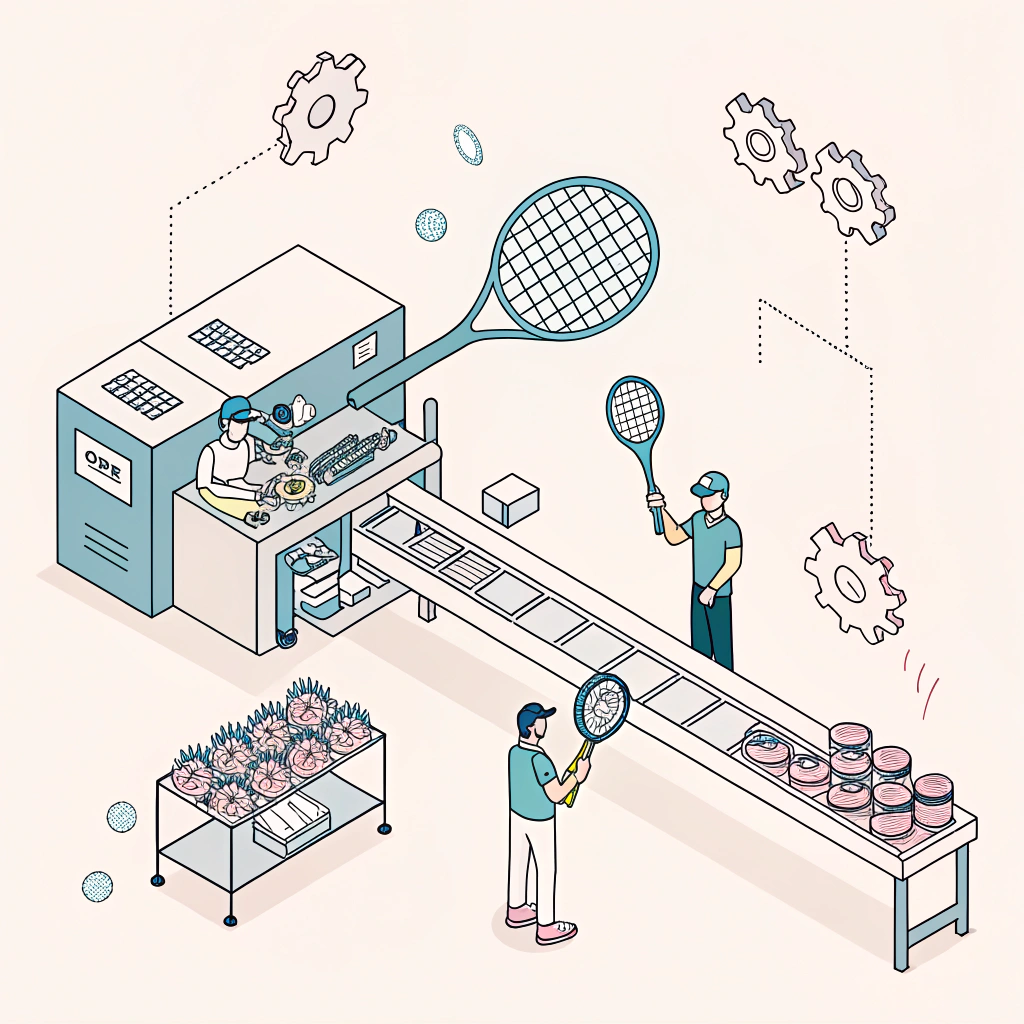Quality assurance in padel racket manufacturing is the backbone of reliable supplier performance—it ensures every product meets stringent standards of durability, precision, and consistency. In this article, we explore the quality control processes in padel racket manufacturing, focusing on materials like carbon fiber1 (3k, 12k, 18k) and fiberglass2, advanced production techniques, and rigorous testing protocols.
In the competitive world of padel sports equipment, maintaining high-quality standards is critical. Quality assurance (QA) managers and procurement specialists must evaluate suppliers not only for cost efficiency but also for production consistency, material quality, and adherence to industry standards. Any deviation in quality can affect performance on the court, potentially altering a player's game and impacting a brand's reputation.
At NEX Padel, we understand that quality is more than a buzzword—it’s the foundation of trust between suppliers and buyers. Our padel rackets, whether they are of the Diamond, Round, or Teardrop design, go through multiple quality control checks to ensure they meet the high standards required by professional players and discerning consumers. These checks include material testing, production process validation, and detailed inspection protocols.
There are several reasons why quality assurance becomes challenging in our industry:
-
Material Variability
Each material, whether it is fiberglass or various grades of carbon fiber (3k, 12k, 18k), has unique characteristics. Variations in material properties can lead to differences in racket performance. Even small deviations can result in inconsistencies in weight, balance, and overall durability. -
Complex Production Process
The manufacturing of high-performance padel rackets involves multiple stages—from design and material selection to production and final assembly. Every step, including molding, curing, and finishing, must be carefully monitored and controlled to ensure the final product meets the specified standards. -
Customization Requirements
OEM partnerships3 and private labeling often demand custom shapes, colors, printing, and additional features like hand grips and handle covers with logo customization. While customization increases market appeal, it also introduces more complexity into the production process, requiring rigorous QA protocols to ensure each modified component adheres to quality standards. -
Technological Integration
The integration of advanced production techniques demands regular calibration of equipment and consistent updating of production protocols. Without strict adherence to quality management systems, even high-tech setups can yield subpar products.
Understanding these challenges is the first step toward developing an effective quality assurance strategy that minimizes risks and guarantees consistent product performance.
To overcome these challenges, suppliers like NEX Padel adopt a comprehensive quality control checklist that serves as the backbone of the manufacturing process. Below is a table summarizing the key quality assurance checkpoints and testing protocols used in padel racket manufacturing:
| Quality Check | Purpose | Methodology | Key Metrics |
|---|---|---|---|
| Material Inspection | Verify quality of raw materials | Visual inspection, material certification | Purity, tensile strength |
| Precision Engineering | Ensure design accuracy | CNC machining4 validation, digital measurement | Tolerance levels, repeatability |
| Production Process Test | Validate process consistency | Sampling analysis at critical stages | Cycle time, defect rate |
| Durability Testing | Assess product longevity | Stress tests, impact resistance tests | Life cycle performance, break force |
| Customization Verification | Check compliance with custom orders | Batch testing, client specification checks | Custom design adherence |
| Final Quality Inspection | Confirm end-product meets all quality standards | 100% visual and dimensional inspection | Pass/fail based on detailed checklist |
Implementing these checkpoints within a quality assurance framework reduces production errors and ensures every product, whether using delicate 12K carbon for a softer feel or robust 3K carbon for stiffness, delivers consistent performance.
The first step in quality control is sourcing high-quality fiberglass2 and various grades of carbon fiber1. Accurate material certification5 and batch testing are mandatory to prevent future discrepancies that might affect product performance. For instance, the difference between 3K carbon and 12K carbon is substantial—the former provides greater stiffness ideal for power-oriented play, whereas the latter offers flexibility for improved control and comfort.
High precision in manufacturing is crucial. Sophisticated computer numerical control (CNC) machines are programmed to create intricate racket shapes, ensuring each component meets the design specifications. Regular calibration of these machines and adherence to rigorous engineering tolerance levels is essential. Each batch of rackets undergoes dimensional measurements, and any deviation is immediately flagged for inspection.
During production, real-time monitoring of the manufacturing process helps to identify and rectify errors immediately. Automated sensors and manual inspections are both deployed. Data is collected at various stages — from molding to curing — and compared against set benchmarks. When discrepancies arise, a detailed root cause analysis is conducted, and corrective actions are implemented on the fly.
Durability testing simulates real-life impacts and stress that a racket may encounter during play. This includes vibration damping tests, shock absorption tests, and repeated impact trials. The data gathered from these tests not only ensures that the product meets performance standards but also provides insights for continuous improvement. At NEX Padel, we use these results to fine-tune material composition in our rackets, ensuring an optimal balance between power and control.
Before dispatch, every padel racket passes a rigorous final inspection. Here, both automated and manual visual inspections are carried out. The inspection covers overall aesthetics, balance, weight distribution, and adherence to any customized order specifications such as logo placement on grips or tailor-made color palettes. This process ensures that each product leaving the factory is a true reflection of precision and quality.
Even with robust systems in place, some common challenges may arise during padel racket manufacturing:
• Environmental Variations: Changes in temperature or humidity during production can affect material properties.
• Equipment Calibration: Even minor lapses in machine calibration may cause deviations in production specifications.
• Human Error: Manual processes, despite automation, still carry the potential for mistakes.
Below is a table summarizing these challenges along with their mitigation strategies:
| Challenge | Impact on Production | Mitigation Strategy | Expected Outcome |
|---|---|---|---|
| Environmental Variations | Material curing inconsistencies | Control climate conditions in production area | Consistent material performance |
| Equipment Calibration Issues | Deviations in precision engineering | Regular maintenance and calibration schedules | Improved dimensional accuracy |
| Human Error | Increased error rate in inspections | Enhanced training and automated inspections | Reduced defects and higher reliability |
Implementing these mitigation strategies as part of an overall quality assurance plan ensures that the risks are minimized, and the production process delivers consistent excellence.
Consider a scenario where a major OEM partner required a customized batch of padel rackets with specific design modifications—altered weights, custom logos, and tailored color schemes. At NEX Padel, our approach involved the following steps:
- Initial consultation with the client to precisely outline the custom specifications.
- Detailed planning with our production team to ensure that all variables, including the choice between 3K and 12K carbon, were correctly applied.
- Execution of enhanced quality checks at each production stage, ensuring that even with customization, every racket maintained our high standards.
- Final batch testing, including stress and impact assessments, confirmed that the products met both standard performance metrics and the client's bespoke requirements.
The success of this case not only reinforced our reputation for precision engineering but also demonstrated that robust quality assurance processes can successfully adapt to varying demands without compromising on product excellence. This comprehensive testing and validation framework is a critical component of our strategy, building long-term trust with our partners.
Quality assurance in padel racket manufacturing is a complex, multi-layered process that requires meticulous attention to detail at every stage—from raw material procurement to final product inspection. The key takeaways for procurement specialists and quality assurance managers include:
• Recognize the importance of rigorous material inspection and precision engineering in ensuring product performance.
• Implement comprehensive in-process quality controls to catch issues early in the production cycle.
• Adopt robust durability and performance testing protocols that simulate real-world conditions.
• Prepare for customization challenges by integrating additional quality checks tailored to custom specifications.
For organizations involved in OEM partnerships, understanding and actively evaluating these quality control measures can significantly reduce risks and enhance product reliability. NEX Padel’s commitment to continuous improvement and adherence to international manufacturing standards makes us a trusted partner for companies looking to ensure that every padel racket meets the highest levels of performance and durability.
To further optimize your supply chain decisions, consider performing regular audits of your suppliers’ QA processes, asking for detailed reports on quality inspections, and, if possible, visiting production facilities to see the controls in action. This proactive approach not only assures you of product quality but also strengthens negotiating power and fosters long-term partnerships built on mutual trust.
People Also Ask
Q1: What is control in a padel racket?
Control in a padel racket refers to the ability to place the ball accurately where you intend. It involves both precision—hitting the exact spot—and comfort, which means the racket provides a forgiving, responsive feel upon impact.
Q2: How to tell a good padel racket?
A good padel racket can be identified by several key factors: the shape and fit, appropriate weight for your play style balancing power and maneuverability, proper balance, handle size and length for optimum comfort, high-quality materials that influence performance and durability, and surface texture that enhances spin and control. These factors contribute significantly to a racket’s performance, as seen in the equipment used by top players.
Q3: Which is better 3K or 12K carbon?
The choice between 3K and 12K carbon depends on the desired playing characteristics. 3K carbon is typically stiffer, which can provide more power, while 12K carbon offers greater flexibility, resulting in a softer feel and improved control during play.
-
carbon fiber: Click to learn more about the properties and applications of carbon fiber in advanced manufacturing, including its benefits in terms of strength-to-weight ratio and durability. ↩ ↩ ↩2
-
fiberglass: Click to explore how fiberglass is used in composite materials for sporting goods, its manufacturing process, and its performance characteristics in high-demand environments. ↩ ↩ ↩2
-
OEM partnerships: Click to read about the dynamics of OEM partnerships in manufacturing, including the benefits of collaborative product development and customization strategies. ↩ ↩
-
CNC machining: Click to understand how CNC machining works, its role in precision manufacturing, and how automated processes contribute to consistent product quality. ↩ ↩
-
material certification: Click to discover the importance of material certification in quality assurance, detailing how certifications ensure compliance with industry standards and verify raw material quality. ↩ ↩







